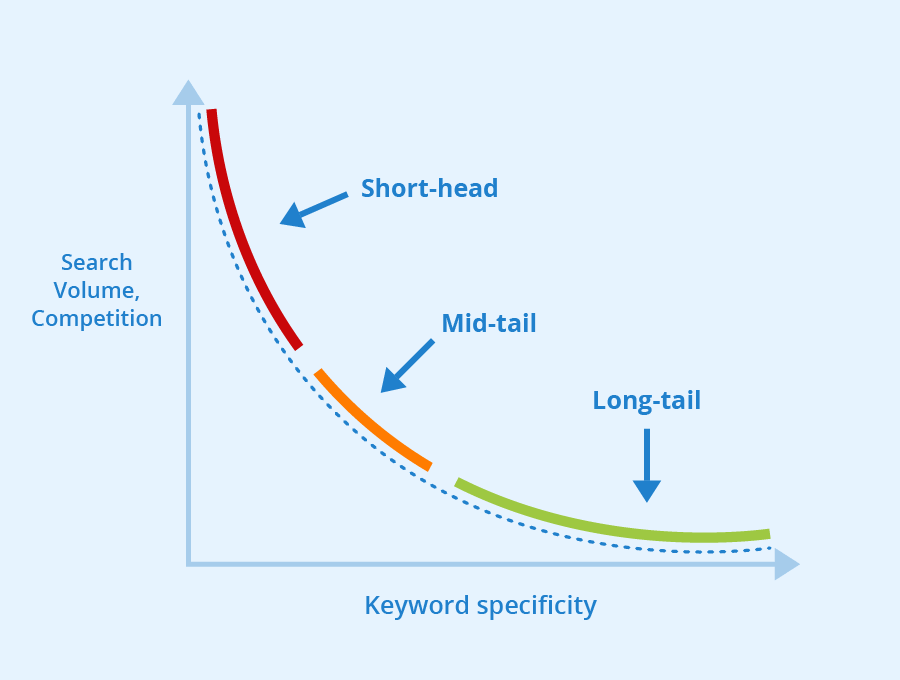
“Understand your audience”
That is my most fundamental mantra for content writing and SEO. I know it may sound too obvious and may not seem like much to you. But trust me, there is a lot of work behind it. I really wish to know what my audience needs and is looking for in my niche before I decide what content to create.
How do I understand my audience? – Through Keyword research.
Keywords are the core of great content if I want organic search traffic. The right keywords bring the right people to you. Right keywords can be found by assessing keyword search volumes for a better strategy.
Let us try to understand through this article, what is keyword search volume and what it means for SEO.
What is Keyword Search Volume?
Keyword search volume refers to the number of times a keyword is searched for in the search engines like Google during a specific timeframe (typically, a month). It is a valuable metric you want in your SEO content strategy to draw more organic traffic to your website.
As an SEO professional, you would have to look at the search keyword volume to determine which keywords are popular and what is the competition.
What is good keyword search volume?
What is good is a relative term.
Does a large search volume mean it is good?
Yes and No.
Does low volume mean it is bad?
Again, yes and no.
The art lies in finding what is important for your keywords and you!
Though high search volume may bring in more traffic, if they are on broad, generic keywords, they may not all convert to clients. It is important to not just draw more traffic but also the right traffic for you. If the search volume is low, it probably means they are barely used in searches. Keyword search behavior depends on several factors.
- Your industry and niche determine the popularity of the keywords.
- Your selected location influences the volume.
- You may want a high search volume with low competition.
- If you use rarely searched words, users may not easily find your content.
- If you use common words, there is too much competition.
- You may also want to keep in mind the size of your site and budget to decide how much you want to invest in your keyword research.
What to keep in mind before you determine keyword search volume?
Seasonal and evergreen keywords:
Some keywords may be popular seasonally like festivals and occasions or something trending at the time. These keywords may have the highest search volume at one particular ‘season’. You can check Google trends to find what is trending.
Evergreen keywords are keywords that hold eternal value and you may find their volumes are quite consistent.
Keyword clusters:
Keyword grouping also impacts potential search volume and hence the traffic. The most common mistake made during keyword research is some people focus on one keyword and its search volume.
Take a step back and look at the bigger picture. Users are smart and they ask specific queries on Google. Let’s take this article for example. Search volume is the keywords.
People are not always searching using these two words. They may also ask, what is search volume? Why search volume is important for SEO, and what are the tools used to determine search volume? What is the correlation between volume and traffic? And many more queries.
By targeting all these keywords, you increase your odds of ranking on any of these queries.
It is a metric that determines how difficult it is to rank for a keyword in Google’s organic search results. It is how much competition there is for that keyword. You will also need to consider this metric along with the keyword search volume.
Keyword relevance:
The importance of a certain keyword to your website, whether it is relevant to the type of content you share.
Why is search volume important in SEO?

When you are armed with the data gained in your search volume results, you will know the value of keywords and their fluctuations throughout the year. You can predict future performance and can make informed decisions in your content and SEO strategy.
- You can prioritize keywords with traffic-driving potential.
- You can create traffic estimates using the average search volume per month.
- You can assess the difficulty/ competition level of the keyword.
- You can determine if they are seasonal.
- This number-driven approach helps you optimize your content.
How is keyword search volume determined?
You need to do keyword research to find the popular keywords. You can make use of either the free tools or the professional tools to find the search volume.
Also, read my article on The Lazy Man’s Guide to Advanced Keyword Research.
Free tools, of course, offer limited options. But here are some free resources you can rely on:
1. Google Keyword Planner/Bing Keyword Planner: They are the most commonly used tools and are among the most effective ones. Users with ads account can request monthly search queries for specific keywords.
2. Google Trends: You can find the trending words, their seasonality and local variations. You can run your keywords through Google trends to predict when these words are searched and it helps you understand the intent of your target audience.
3. WordStream: This is an amazing tool that gives you topical keyword suggestions for your keyword search for other related keywords in that niche. It also shows you search volume and competition.
4. Keyworddit: It is a Reddit keyword research tool extracting keywords from its expansive community. It shows search volume data besides keyword suggestions which can be exported as a CSV file.
If you are an SEO professional or a marketer, and a serious one, then I suggest you go for the paid tools to make the most of what they provide, to stay on top of the game.
The tools will provide more than just keyword volume that would be handy to determine your keywords, like keyword difficulty metric, search trends, CPC and PPC values, domains, traffic, and others.
1. Ahrefs
You can check all the keywords you are ranking for along with search volume, traffic potential, keyword difficulty score, and other metrics.
2. KWFinder:
This tool gives you advanced filters, exact search volume, difficulty metric and hundreds of keyword suggestions, a regularly updated database, your competitor’s keywords, and SERP data to assist you in your keyword research.
3. SEMrush:
It is a popular SEO tool used for keyword research with a database of about 17 billion keywords from Google and Bing, reveals the number of searches for a keyword in your preferred location, search volume, trend analysis, and other SEO metrics.
4. Moz: The Keyword Explorer by Moz displays keyword search volume, difficulty, opportunity, and potential. It also gives you keyword suggestions and SERP analysis.
Are search volumes accurate?

Hardly!
The Google Keyword Planner is considered the best source for search volume data and several SEO tools depend on Google data to collect search volumes.
You can turn to the Google Search Console for the ultimate truth. Say you are ranking for a specific keyword, its actual search volume is the number of impressions your page has received for that keyword.
An experiment by ahrefs compared the impressions on GSC with the search volumes in GKP for the same keyword to assess the accuracy. The results revealed that the search volumes in GKP were largely overestimated and were roughly accurate only 45% of the time.
So what now all this work is a waste of time?
Well, not entirely.
Tools like Ahrefs have their own approach to determining search volume.
How do Ahrefs (and other tools) calculate search volume?
The main sources of search volume that are used in tools are Google data and Clickstream data.
1. Google data
It is the most commonly used resource for search volume data as Google has an amazing massive database.
The data here usually shows search volume for a cluster of keywords instead of a single keyword.
Topically similar words, usually long-tailed keywords are grouped together which can be used to process and show more specific results.
2. Clickstream data
This data is collected through browser extensions, plugins, and other apps installed on your computer which is aggregated for use.
This includes data that Google data does not. They offer smaller fragments of data that are less accurate than that of Google.
The clickstream data is also used to find the Click-through rate curve to check if people are clicking through in the search results and is shown as the click metric.
Clickstream data can also differentiate between subtle variants of a keyword. While Google data groups together singular/plural of words, typos, abbreviations, implied words, synonyms, paraphrases, and words you may not use, but terms with the same intent, clickstream data-based volume can disambiguate multiple versions of the terms and give their own volumes.
A combination of both Google data and clickstream data is used to determine accurate search volumes for any given keyword.
This disambiguation and ungrouping of words make the search volumes more accurate than that of GKP.
End of the day, these are estimates and not precise values.
The moral of the story is you should NEVER be completely depending on search volumes alone.
Best SEO practices for search volume

Let me point out that the search volume tells you the number of times the keyword was searched on the search engine rather than the number of people that searched for it. This can be a common cause of misconception.
It means that, if a search volume for a keyword is 100, it means the word was searched 100 times and not necessarily by 100 people.
Navigational search words often have a high volume but serve no purpose to you. Words like Amazon, and Facebook may be the target for users, but they would just type in those words instead of typing the URL for search.
This and other contingencies call for you to follow some best practices when it comes to finding search volume for SEO.
1. You should not be relying on search volume alone. You also need to check user intent competition, traffic potential, click-through rates, and other metrics.
2. You should not be after only keywords with high search volumes. All searches do not result in clicks. Google’s goal is to provide answers in the earliest way possible. If users find their answers visibly on the results page, they don’t click.
3. Keep an eye out for the trends. Search volumes are high for some words at a given time and may not be high all the time.
4. If it makes complete sense for you to use a keyword in your niche, it is okay to ignore its search volume.
5. Low-volume keywords are worthy too. If you have a small and new niche, users may not be familiar with the terms. It is your job to build relevancy and educate users.
6. Try the data-driven strategy called KGR (Keyword Golden ratio), which I am sure, deserves an honorable mention in keyword research. It is the value you derive from dividing “allintitle” results of a keyword with its search volume
This method is used for identifying long-tailed keywords that are not covered in depth by other websites. If the KGR value is below 0.25, then you can rank in the top 100 when your page is indexed.
What is the difference between Search Volumes, Search clicks, Search impressions, and Search traffic?
Search Clicks can be found in your Google Search Console. It is a metric that indicates the number of times users have clicked on your URL from the search results page which was displayed as a response to the search query made by the user.
Search impressions are how often someone has seen (or potentially seen) a link to your site in Google Search results, Discover, or News, even scrolled through, as long as they have not clicked to see more results.
They are not a reliable indicator for search volume.
But both clicks and impressions can be used to assess how to improve SEO.
Search traffic, found in your Google Analytics, is a metric displaying data on the traffic to your website from Google.
It is about measuring SEO results. Search volume is about predicting Search traffic your website would receive on ranking in the search results.
Final thoughts
Enough said about what-does-it and how-does-it of search volumes. Keyword research is a crucial process in content creation and comes with nuances and complexities. The keywords you use play a role in how your content performs.
It all comes down to what works for you. I hope you will use the information I shared, to improve your keyword research process.
Keyword search volume is a handy weapon in SEO, which when wielded wisely, you can try to give what your audience wants and improve your conversion chances. It’s a win-win!
Do you have any opinions, tips, or suggestions on search volumes?
Hit me up in the comments.


